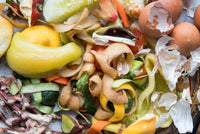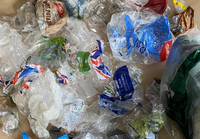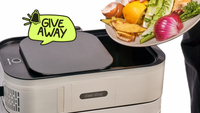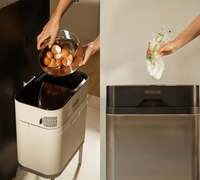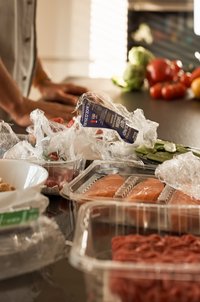In the United States, food scraps make up a significant share of household waste, yet only about 5% of organic waste is composted. As electric composters gain popularity, many homeowners believe they are creating usable compost - but environmental experts argue otherwise. This guide explains the differences between electric composting, true professional composting, and new home-friendly technologies that actually support a circular system and help reduce methane emissions from landfills.
According to the U.S. Environmental Protection Agency, "only about 5% of the annual 66.2 million tons of food waste is composted", which leads to landfill overfilling and emissions of methane.
The rising environmental needs for composting and new legislations in separating organic waste for households create a new market for solutions and home appliances. This market for various devices for composting or preparing food scraps to compost-like material is already overcrowded by different technologies. Here also comes electric composters, which have become a separate category, and are being introduced by more and more brands these days.
They claim to conveniently convert organic household waste into plant food or soil amendments without unpleasant odors or pests. But do they really make compost that can enrich the soil and introduce a genuine solution, or is it a misleading trend? This is a point that has been questioned by many environmental experts and gardeners.
Let’s look at the facts!
How do electric composters work?
The features of electrical composters may vary from the producer, but the general logic of their work stays the same. Basically, all of them use heat, grinding, and aeration technologies inside the devices to dehydrate and grind up organic waste.
They get rid of bacteria and pathogens while heating your organics to a high temperature, depending on the model, to about 160°F or over 212°F. During the heating process, the device starts to grind your food scraps into small pieces into dry brown powder or chunky and fibrous material, depending on what waste you have. The rotation of the material and charcoal filter simulates compost aeration and helps to prevent odors.
This process takes a few hours and reduces the volume of your organic waste to 70-90%. That sounds perfect for keeping your kitchen odor-free and pest-free, but suspicious about fully dehydrated and ground material being used as a compost that usually needs microbial decomposition and compost bacteria for benefiting the soil.
The composting misconception
Despite marketing claims, the material that is the final product of electric composters’ work is not one that can be called compost and doesn’t have the same ‘composting magic’ features to help plants grow better and contribute to soil health. Even naming it differently can’t guarantee good output for the soil, as it’s declared by electric composters’ brands.
“Right from the moment that I saw the first unit, I questioned the 'composting' aspect. How can they compost so quickly when composting is a very slow process?” – said Robert Pavlis, an educator, gardener, blogger, writer and chemist, in an interview with GardenMyths.com.
As stated by the U.S. Environmental Protection Agency, the output from these devices is more accurately described as "dehydrated food waste byproduct" rather than compost. This material is not biologically stable and often requires further decomposition before it can be safely and effectively used in soil. Applying it directly to plants may not grant the intended benefits to soil health and could potentially harm plant health due to incomplete decomposition and possible high salt content.

Some of the tests of environmentalists challenge the statements of electric composter producers, showing that the final material could be detrimental to plant growth and does not eliminate the odor of food scraps, which can attract pests.
As outlined by horticulturist Ron Alexander, "it’s not only the missing bacteria that may be problematic, as the freshly ground material can contain concentrated levels of certain nutrients and salts that, when added to garden beds, create an imbalance in the soil's nutrient profile". It may also heat up during the decomposition process, harming plant growth. In addition, the organic waste could become moldy or attract pests if immediately used in the garden.
In cities where composting options are limited, such devices provide a practical way to separate food scraps. But since they don’t make a real compost, meaningful progress in reducing food trash and proper composting requires a professional approach and participation of municipal systems.
Professional composting: a sustainable alternative
Unlike electric devices that grind and dry organic waste without microbial action, professional composting systems rely on natural decomposition to produce true compost.Professional composting, as understood by the US Composting Council, involves large-scale, controlled composting processes that handles significant volumes of organic waste and ensures rapid decomposition under managed conditions.

What are these conditions, and why can they process organic waste more efficiently than home setups?
The professional composting process entails the following steps:
- aerobic decomposition with oxygen;
- strictly controlled temperature, humidity, and airflow levels conditions;
- the use of microorganisms and sometimes mechanical turning or forced aeration to speed up the composting process.
One of the main differences between professional and home composting is time. A professional composting service will create the ideal conditions for the breakdown of organic waste into efficient compost, supporting soil health.
Another key difference is in the variety of waste that can be composted. Professional composters can handle a much wider range of organics, including things like bioplastics and bones, that can’t be processed in domestic outdoor or indoor compost bins.
Alternatives as part of the solution
For those seeking to make a meaningful contribution to sustainability, engaging with professional composting services or traditional composting methods is advisable.
By supporting systems that produce genuine compost, individuals can enhance soil health, reduce greenhouse gas emissions, and participate in a more sustainable waste management cycle. At the same time, there are other solutions for those households for whom doing a traditional compost is not an option and coping with flies, leaks, and odors is a mission.

At Clear Drop, we investigated the current issues with organic household waste management and solutions with their benefits and drawbacks to introduce our own technology. We created a kitchen appliance, Organics Collector, that solves the challenge of convenient household organic waste management without full dehydration.
Suppression of your organic waste is carried out using a combination of 3 technologies: dry without heating, aeration, and ozone treatment.
Drying reduces the moisture content of your food scraps and other organic waste by only 30-40%, which is still preserves the essential organic matter, allowing it to be effectively composted in industrial facilities or in your own or community pit.

Aeration is the process of saturating the waste mass with air.
Ozonation - regular treatment of the contents of the container with limited and safe doses of ozone. Additional protection for the consumer from unpleasant odors is carbon-filter adsorption.
With its help, all air coming out of the device is filtered and cleaned.
While electric composters offer convenience, they fall short of delivering true compost or contributing meaningfully to soil health. Real sustainability lies in supporting systems that return nutrients to the earth through natural decomposition. Whether by engaging with municipal composting services or exploring home methods rooted in biology, the smarter path is one that nurtures soil, not just simplifies disposal. In tackling organic waste, we need solutions that close the loop - not just reduce volume.
Home Solutions for Cleaner Organics Collection
Managing food scraps at home becomes much easier when the right system is in place. Follow these practical steps to keep your organic waste clean, odor-free, and compost-ready:
- Keep food scraps separate from plastic packaging and other trash.
- Store organics in a sealed container to prevent mess and odors.
- Limit moisture and airflow exposure to slow decomposition and avoid pests.
- Use a home appliance that stabilizes food scraps without destroying their organic value.
- Deliver properly stored organics to municipal or professional composting programs where true composting occurs.
Clear Drop® Organics Collector (OC) was designed specifically for this purpose. It prevents odors, reduces leaks, and keeps food scraps suitable for real composting—unlike full-dehydration devices that destroy nutrient value.
Make Organics Management Easier at Home
Clear Drop® Organics Collector stabilizes food scraps using drying without heating, aeration, and ozone treatment - keeping them ready for true composting. Cleaner kitchen, fewer odors, better waste habits.
Learn more about the Organics Collector.
Frequently Asked Questions
Do electric composters make real compost?
No. The product they create is usually a dehydrated food waste byproduct without the microbial activity needed for composting. It still requires decomposition before being applied to soil.
Why does professional composting matter?
Industrial facilities process organics under controlled conditions with microorganisms and aeration, creating nutrient-rich compost that improves soil health and reduces methane emissions.
How can households support proper composting if a backyard bin isn’t an option?
Use certified collection programs, community composting, or home appliances that stabilize food scraps while keeping them compostable.
Is odor control important in home organics management?
Yes. Odors attract pests and lead to contamination. A sealed, aerated solution prevents this and makes waste collection more consistent.




